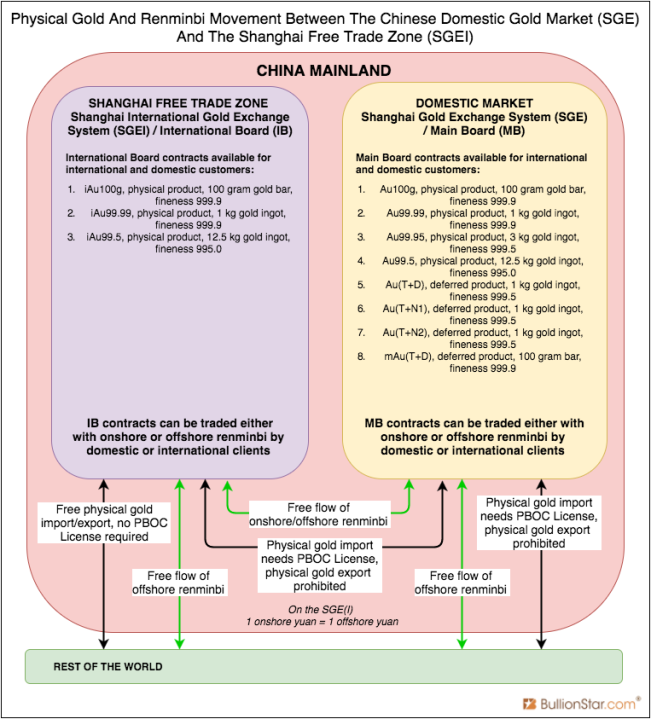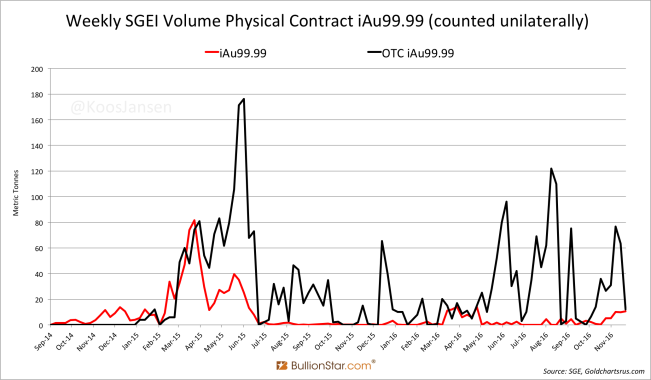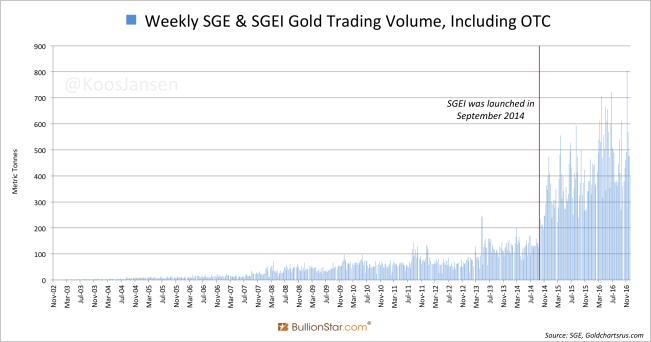China’s Gold Market to Boost RMB Internationalization
Last week the Shanghai Gold Exchange (SGE) launched a new English website to offer international customers more information and tools on trading gold in renminbi through its subsidiary in the Shanghai Free Trade Zone the Shanghai International Gold Exchange (SGEI). BullionStar took the opportunity to translate a speech by a Teng Wei, Deputy General Manager of the SGEI, named “How China’s Gold Market Can Help The RMB Achieve International Status” that was held at the Renminbi World summit in Beijing on the 29th and 30th of November 2016. In the speech Teng Wei outlined his vision for the SGEI going forward regarding renmibi (RMB) internationalization, connecting the onshore and offshore renminbi market and increasing gold market share.
My comment before you read the translation:
1) In the financial blogosphere the general perception is that the SGEI has been a failure since it was launched in September 2014. This analysis is based on the assumption that the trading volume of the most popular SGEI contract (1 Kg 9999 – iAu99.99) has been tepid for two years now. But this analysis neglects two important elements.
First, iA99.99 can be traded competitively “on Exchange”, but also in the OTC market. The OTC possibility is hardly known by commentators in the English world, though the related volumes are significant. Have a look at the next chart in which I’ve plotted iAu99.99’s weekly trading volume “on Exchange” and in the OTC market. Clearly iAu99.999 is traded mainly in the OTC market.
Second, international customers of the SGEI can not only trade the SGEI gold contracts, but they can also trade SGE (domestic) gold contracts. Logically, as at present liquidity on the SGE is much higher than on the SGEI, many international customer that seek to trade gold in renminbi, and don’t need to export the metal, will choose to trade SGE gold contracts.
When observing total trading of all SGE(I) gold contracts, there is a clear rise in volume since the SGEI was launched.
Up till now international customers are mainly trading SGE contracts. The significant rise in trading volume of all SGE(I) contracts since September 2014 is due to the inception of the International Board (SGEI). In the second week of November 806 tonnes was traded on the SGE(I), the highest amount ever.
So the launch of the SGEI has not been a failure in my opinion – it has elevated gold trading in (offshore) renminbi.
For more information please read my post The Workings Of The Shanghai International Gold Exchange or have a look at the graph below.

2) Teng Wei mentions that in 2015 gold demand in China and India was 985 and 849 tonnes respectively. In the case of China this refers only to consumer demand, not institutional demand. Chinese consumer and institutional demand in 2015 combined was well north of 2,000 tonnes.
For more information please read my post Spectacular Chinese Gold Demand 2015 Fully Denied By GFMS And Mainstream Media.
3) A gold exchange doesn’t flourish overnight. The SGE was launched in 2002; in that year its total trading volume was 22 tonnes and withdrawals accounted for 16 tonnes. Ten years later total trading volume was 3,175 tonnes and withdrawals accounted for 1,138 tonnes. In 2015 total trading volume was 17,033 tonnes and withdrawals accounted for 2,582 tonnes. The development of the SGE, becoming the largest physical gold exchange globally, took time and it can be no different for the SGEI.
Document Translation [brackets added]:
Teng Wei: China’s Gold Market Opens Up To Boost RMB Internationalization
The 2016 RMB summit was held in Beijing on the 29th and 30th of November. Deputy General Manager of the Shanghai International Gold Exchange Center Teng Wei participated in the forum and discussion on “How China’s Gold Market Can Help the RMB Achieve International Status”. He expressed that using Shanghai’s free trade zone status, investors can open trading accounts denominated in RMB and participate in trading directly through the Exchange’s international board [SGEI] that allows access to most of the precious metal products that are traded in China. The international board has developed relatively well since establishment with active participation from international members and steadily increasing trading volume.
Gold on the international board is quoted and settled in RMB, which effectively connects the RMB onshore market and offshore market. This will extend the scope of RMB usage across borders and provide a new channel for inward capital flows. It is a move that is beneficial to expand the RMB usage to steadily promote internationalization of the RMB.
The actual speech:
Ladies and gentlemen, good afternoon, I am Teng Wei from the Shanghai International Gold Exchange. I am delighted to participate in this forum organized by the Asian Bankers Association to have a chance to speak and interact with everyone about opening China’s gold market to the world and how that can help the internationalization of the RMB.
This afternoon, I would like to touch upon on three topics. The first topic is the new pattern of the internationalization of the RMB and the global gold market. China’s gold market was established in 2002 with the launch of the Shanghai Gold Exchange. If anyone is familiar with the history of China’s gold market, you will know that before the year 2002 the Chinese gold market was entirely ran by the People’s Bank of China, including the process of purchasing, allocating and storing of gold. There wasn’t a single unified market where all participants could trade at the same time. Since the year 2002, with approval of the State Council, the People’s Bank Of China developed gold spot trading on the Shanghai Gold Exchange, as well as gold futures trading and over-the-counter trading via commercial banks, etc, which formed the basis for a multi-level diversified gold market system.
While the Chinese gold market was developing rapidly, the pattern of the global gold market was also having a dramatic change. As time passed, the international gold spot market was heavily concentrated in London and the international gold futures market has been concentrated in New York. However, in recent years, with the rise of gold demand in China, India and other Eastern nations, and with the exit of European and American banks from the precious metals market, it’s clear that Western gold is moving to the East. In 2015 gold demand in China and India was at 985 tons and 849 tons respectively. These figures alone account for 45% of global [consumer] gold demand. With gold demand from other markets dipping to various levels, China is not only the world’s largest gold producer and importer of gold, but has also become the world’s largest gold consumer.
Just now, I mentioned that the two main centers for gold trading are London and New York, and the current situation is Western gold flowing to the East. Everyone, have a look at some statistics that I have here, showing that just China and India alone make up over 45% of global gold demand. This was last year’s data.
Since the year 2005, when the RMB exchange rate was reformed, international investors’ willingness to trade in RMB denominated assets has also increased. This has objectively enhanced the Chinese gold market’s international status and garnered attention. In recent years, the RMB exchange rate is expected to have some changes.
The Shanghai Gold Exchange provides the important infrastructure for China’s gold market. ECB officials have mentioned that an important part of promoting the internationalization of the RMB is having a good financial market infrastructure. The exchange is also an important “all-in-one” foundation for gold transactions, clearing, delivery and storage. It serves with the commitment to provide gold investors with efficient and convenient market services. It has been 14 years since establishment of the exchange in the year 2002 and development has been rapid with annual trading volumes increasing 40% on average.
At the end of 2015 there were over 8.6 million individual accounts, over 10,000 institutional accounts and the total gold trading volume for the year reached 17,000 tonnes. The exchange was ranked as one of the largest and we firmly grasped an important opportunity for the internationalization of the RMB with the profound changes happening in the gold market. At the same time, we want to build a harmonious ecological gold market that sets a new path for the global gold market and achieve the status of being a global gold power from a large gold holding nation.
For the second point, I would like to explain how opening up China’s gold market externally to the world can help the internationalization of the RMB. To further promote and innovate China’s gold market, on 18th September 2014, the Shanghai Gold Exchange set up an international board [SGEI], open directly to foreign investors. This move has effectively connected China’s domestic gold market and the international gold market. Using Shanghai’s free trade zone, investors can open trading accounts denominated in RMB and participate in trading directly through the exchange’s international board that allows access to most of the precious metal products that are traded in China. The international board has developed relatively well since establishment with active participation from international members and steadily increasing trading volume.
As of now, the exchange has 67 international members, including most of the world-renowned gold suppliers and traders like Mr Thomas McMahon, who is also our Exchange’s member. At the end of the third quarter of 2016, the international board had recorded a total of 7,837 tonnes of gold traded, with a turnover valued at nearly 200 billion RMB. The Shanghai International Gold Exchange is the test pilot and pioneer for opening up China’s gold market to the world. It is significantly important for further increasing the capacity, expansion and international influence of China’s gold market. In addition, the international board uses RMB for settlements, producing an effective convergence of the RMB offshore and onshore markets, expanding the cross-border use of the RMB and providing a new channel for return of funds. All these points steadily promote the internationalization of the RMB and serve as a useful exploration.
For RMB denominated gold products to gain popularity outside of China, we think the prerequisite is to provide a fair offering for global gold market transactions, with reliable gold benchmark pricing in RMB, using the Shanghai Gold Exchange benchmark pricing mechanism [Shanghai Fix] for our trading platforms. The weight of the gold traded is 1 kilogram, with a fineness of no less than 99.99%. Using a price inquiry method and market volume, a balance is reached to form the benchmark price of gold measured in RMB. The price announcements will be released externally each trading day at 10:15 and 14:15.
At present, the Shanghai gold benchmark price is being used by domestic gold producers and suppliers for hedging and settlements. More and more commercial banks are also using the Shanghai gold benchmark price for gold leasing and financing as the standard. More and more products linked to the Shanghai gold benchmark will be made available.
Other than domestic usage, the Shanghai gold benchmark price is also being actively studied more and more by external markets regarding its application. In October, the exchange signed an agreement with Dubai for the right to use the Shanghai gold benchmark price and authorization was given for the Dubai gold exchange to use the Shanghai gold benchmark price as the standard for offshore RMB denominated futures. The signing of this agreement marks the use of the Shanghai gold benchmark price in international financial markets for the first time. This greatly helps to elevate the international influence of the exchange in global markets and improves the image and reputation of the RMB abroad.
For the third point, I would like to share with everyone how the Shanghai Gold Exchange acts as an important infrastructure for internationalization in three steps. As the forerunner for opening domestic markets and innovation, the Shanghai Gold Exchange cannot forget its historical mission. We are determined to take the international and market-oriented strategy.
Overall, for the internationalization process, we have three steps to take. The first step is to be open and inclusive, actively inviting foreign investors to come in. Just now, we have introduced our international board after the establishment of the Exchange and we will continue to increase publicity efforts. In accordance to high standards and multifaceted principles, we will continue to increase and expand international membership of the Exchange. Accordingly, we have carried out a variety of promotional activities in major financial hubs and countries and regions along the new Silk Road to allow more international market participants to hear the sound coming from the Chinese gold market. The exchange also takes the opportunity to actively learn from the experience of advanced international markets in the optimization of various trading systems and innovation of all kinds of trading products.
For the second step, since we have invited guests inwards, we also have to step outwards. Through cooperation and win-win situations, the gold Exchange can be promoted and step out of China. The Shanghai gold benchmark price has now taken a first step with the Dubai Gold Exchange agreement. This can be considered an ice-breaking move and serve as a cooperation model for other overseas markets and improve the recognition, branding and acceptance of the Shanghai gold benchmark price. Taking this as an opportunity, the Shanghai Exchange, together with the Chicago Mercantile Exchange (CME, COMEX), the Hong Kong Stock Exchange, the Malaysian Stock Exchange and a number of foreign exchange markets explored on long-term cooperation mechanisms that will allow foreign investors to directly participate in our gold market, in RMB denominated gold trading, standard gold settlement, and many other aspects and modes of cooperation that will increase the Shanghai Gold Exchange’s international market influence.
The third step is to realize RMB internationalization and increase global transaction on the exchange through integration and upgrades. As the international financial markets continue to merge and develop, market boundaries are increasingly blurred and we believe that market fragmentation will be removed gradually. In recent years, we can all notice that there are more and more mergers and acquisitions among major exchanges in the world. We hope to learn from the experiences of such joint stock mergers and acquisitions between global exchanges and explore the different modes of industry integration with overseas exchanges. By offering a wide range of local and overseas products through an open platform [SGEI], we hope to create a world class exchange group. The journey of the internationalization of the Shanghai Gold Exchange will epitomize the opening of China’s financial markets to the outside world and play an important part in the internationalization of the RMB. With Shanghai becoming the third most important market in the world after London and New York, the Chinese gold market will make a great contribution to the internationalization of the RMB. Thank you everyone.
Popular Blog Posts by Koos Jansen
 China’s Secret Gold Supplier is Singapore
China’s Secret Gold Supplier is Singapore
 Audits of U.S. Monetary Gold Severely Lack Credibility
Audits of U.S. Monetary Gold Severely Lack Credibility
 China Gold Import Jan-Sep 797t. Who’s Supplying?
China Gold Import Jan-Sep 797t. Who’s Supplying?
 The Gold-Backed-Oil-Yuan Futures Contract Myth
The Gold-Backed-Oil-Yuan Futures Contract Myth
 Estimated Chinese Gold Reserves Surpass 20,000t
Estimated Chinese Gold Reserves Surpass 20,000t
 Did the Dutch Central Bank Lie About Its Gold Bar List?
Did the Dutch Central Bank Lie About Its Gold Bar List?
 PBOC Gold Purchases: Separating Facts from Speculation
PBOC Gold Purchases: Separating Facts from Speculation
 U.S. Mint Releases New Fort Knox Audit Documentation
U.S. Mint Releases New Fort Knox Audit Documentation
 China Net Imported 1,300t of Gold in 2016
China Net Imported 1,300t of Gold in 2016
 Why SGE Withdrawals Equal Chinese Gold Demand and Why Not
Why SGE Withdrawals Equal Chinese Gold Demand and Why Not




 Koos Jansen
Koos Jansen












